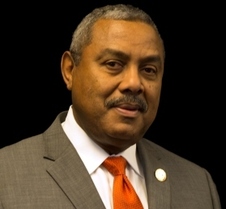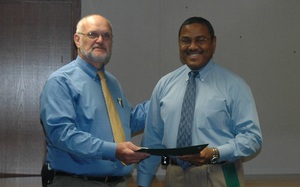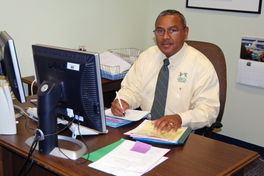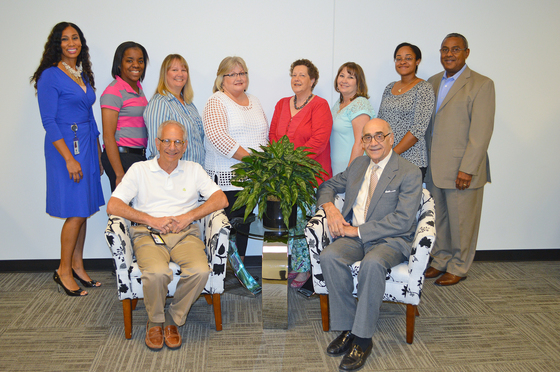|
Summer 2017


The Oklahoma Health Care Authority (OHCA) board approved the agency’s state fiscal year (SFY) 2018 budget work program during their June 29 meeting, noting that in all likelihood, it will need to be amended during the year.
“Our agency was fortunate that state leadership tried to hold our appropriations as level as possible," said OHCA CEO Becky Pasternik-Ikard. "We appreciate their efforts.”
The agency requested $69 million above last year’s base in order to maintain the program at the SFY17 level. The increase was needed mainly due to declining federal matching funds. While the agency was appropriated an increase, it was about $35 million less than the $69 million that was needed.
To accommodate the shortfall, OHCA plans to push a claim run from June 2018 into SFY19, which begins July 1, 2018. The agency normally pays its providers on a weekly basis, making 52 claim runs per year.
The agency is also faced with the possibility that the federal government will not vote to reauthorize the enhanced federal matching dollars which were approved through the Affordable Care Act (ACA) for the Children’s Health Insurance Program (CHIP). A vote on the measure is expected this fall. Should the enhanced CHIP funding not be reauthorized, the agency stands to lose about $50 million in federal funds in SFY18. To accommodate for this loss in funding and to file a balanced budget, the agency plans to push two additional claim runs into July 2018 meaning the agency will make 49 payment cycles to providers in SFY18 as opposed to the regular 52 runs.
“We will certainly be monitoring activities at both the state and federal levels,” Pasternik-Ikard said. “Should Congress reauthorize the enhanced CHIP funding, we will bring needed adjustments back to the board as soon as possible.”
Back to top
|


OHCA Chief Dental Officer Leon Bragg, D.D.S., will retire on July 13, 2017. Dr. Bragg became the OHCA’s first full-time dentist on Feb. 23, 2004.
In his position at OHCA, Dr. Bragg has helped develop program policy for dental care for SoonerCare members, established benefits standards for quality, and assisted with utilization review for the program. He has also served as a liaison between OHCA and its dental providers.
In addition to his role at OHCA, Dr. Bragg has been active in several local, state and national dental organizations. Most recently, Delta Dental of Oklahoma recognized Dr. Bragg for his service and leadership as president of the national Medicaid Medicare CHIP (Children's Health Insurance Program) Services Dental Association (MSDA). In June 2006, he was invited to fellowship in the American College of Dentists, a non-profit professional organization comprised of dentists who have demonstrated exceptional leadership and contributions to the profession and their community. Dr. Bragg has also served as president of the Board of Directors for Community Health Centers, Inc.
Prior to his OHCA employment, Dr. Bragg maintained a private practice for more than 20 years. Later, he served as assistant professor in Operative Dentistry and Dental Materials at the University Of Oklahoma College Of Dentistry. During his time there, he completed a Master of Education degree from the University of Central Oklahoma and graduated from the Oklahoma University Health Sciences Center Faculty Development program. Dr. Bragg was also the first Langston graduate to attend, and the second black to graduate from, the University of Oklahoma College of Dentistry. On Aug. 1, 2003, Dr. Bragg was named assistant dean for Clinics, the first black to hold this distinction in the history of the dental college.
To learn more about the SoonerCare Dental program, click here.
Connect your patients to Soonercare Dental info: okhca.org/dental.
Back to top
|


Sometime in early 2003, the state of Oklahoma determined the experiment in dental managed care wasn’t an appropriate solution for the SoonerCare (Oklahoma Medicaid) program. State leaders made the decision to bring the program in-house at the Oklahoma Health Care Authority, which would self-administer the SoonerCare dental program.
OHCA chose me to tackle the job. I brought with me 21 years of experience as a Medicaid dentist and five years as a full-time faculty member at the University of Oklahoma (OU) College of Dentistry, of which I was assistant Dean of Clinics upon my departure.
At the end of 2003, there were 359 dentists with SoonerCare contracts, and the program had invested approximately $50,000 toward oral health maintenance for Oklahomans. Dental Manager Ella Matthews, R.N., was the only full-time person attending to these matters.
|

At the time I began work at the OHCA on Feb. 23, 2004, the major issue was Medicaid’s structural weaknesses. These faults stemmed from policies that made the program inadequate to meet oral health needs. Mike Fogarty, then CEO of OHCA, said to me, “We have problems with dental. Less than 100 dentists are accepting our recipients, and the oral surgeons are boycotting the program. Fix it!” And so, my journey began.
It was time to end all activities of the managed care programs in the state and implement sustainable dental public health care to meet the needs of our members. Mrs. Matthews was fully supportive of my efforts. Her experience and knowledge of the agency was fundamental to the success of the changes.
It is difficult for some to understand the importance and impact of SoonerCare because the program is so large and serves so many different population groups.
|

This was a window of opportunity for me due to the managed care crisis, as policies under that system did not serve us in the economic and social times. While others discussed ideas, I sought realistic solutions at reasonable costs. To be successful would take broad support and action. Medicaid makes a positive difference in the lives of hundreds of thousands of low-income Oklahomans, and the OHCA allowed me to create a quality dental program.
OHCA increased the reimbursement rate paid to dentists in January 2004. This was helpful and needed. The annual report for SFY 2004 indicated that SoonerCare covered roughly 463,000 low-income children and just more than 60,000 low-income adults in families with children. This made SoonerCare a major economic factor in the dental community. By the end of 2004, Dental Services had grown to include 454 contractors.

Our contracted partners had grown to 804 by 2008. I had 519,880 children (members under age 21) in our program, and the OHCA invested $125 million into the Oklahoma dental community and the state.
Administering a Medicaid program is challenging. One must consider the varied member groups; the scope of the benefits packages; interactions with other payers; regulatory and political transactions; joint federal and state financing and most certainly the effect of all of this on my dental colleagues.
While it’s time for me to retire and move on to the next phase in my life, the work must continue to educate on the value of oral health. Partner dentists must continue to care for the needy while understanding that agency staff will do everything possible to ensure that appropriate services are provided to SoonerCare members. Focus must continue to be on increasing the reimbursement for dentists and improving the quality of services rendered.
Back to top
|

Effective May 1, 2017, OHCA updated the HLD Index of Malocclusion. OHCA gave notice of this change in Provider Letter #2017-06.
Providers can download the updated form (DEN-6) from the OHCA website at okhca.org/forms. Please update your system accordingly.
Please note that all requested information should appear on your documentation: provider name and ID, member name and ID, dates, signatures and scoring. Any incomplete documentation will be returned. In addition, any form submitted that is altered or changed from the OHCA-designated form will also be returned.
Thank you for your cooperation. Please call 405-522-7401 if you have questions.
Back to top

You and your staff are invited to attend the fall 2017 SoonerCare Provider Training Workshops hosted by OHCA and HP Enterprise Services.
- Lawton September 28
- Durant October 5
- Tulsa October 11 - 12
- OKC October 25 - 26
- Guymon TBA
OHCA highly recommends that all providers attend a workshop in their area. Mark your calendar today!
Class descriptions and registration details will post to the provider training page of our website when they are available.
Back to top
|

July is National Cleft & Craniofacial Awareness & Prevention Month (NCCAPM), an observance established by public charities AmeriFace and cleftAdvocate.
Cleft and craniofacial conditions affect thousands of infants, children, teens and adults in the United States each year. Some are born with congenital anomalies like cleft lip and palate, others with more complex, life-threatening craniofacial conditions. Some are burned; others are injured in accidents and animal attacks, or diagnosed with various oral/head/neck and skin diseases.
NCCAPM and its partner organizations maintain a variety of programs throughout the year. These programs offer support and education services for patients and families and promote public awareness. For resources or more information, please visit NCCAPM online at nccapm.org.
In addition, the Cleft Palate Foundation (cleftline.org) offers resources for health care providers as well as parents. These materials include instructional feeding videos and other educational information, awards, scholarships and research grants.
Back to top


The New York Times analyzes the health claims that William Wrigley Jr., founder of the Wrigley Company, made in the 1930s about the company’s chewing gum. In a letter mailed at the time, Wrigley wrote that chewing gum “is good for children’s teeth, which need more exercise than they get with modern soft food.”
According to Dr. Jade Miller, president of the American Academy of Pediatric Dentistry, there is no evidence supporting this or other claims of oral health benefits from chewing the gum sold in the 1930s, which all contained sugar. However, the article notes that since then, “dental experts have come to the conclusion that chewing sugar-free gum after meals increases the flow of saliva, which can help clear sugars and bacteria from the mouth, neutralize plaque acids and strengthen teeth, all of which can help to prevent cavities.”
In addition, Dr. Miller said the increased salivary flow may be particularly beneficial for people with xerostomia, also known as dry mouth. “That [dry mouth] can be caused by a lot of medications or medical problems, and increased salivary flow can really be helpful for reducing the risk of cavities,” he said.
The ADA provides a list of sugar-free gum products with the ADA Seal of Acceptance. Additionally, the oral health topics on ADA.org and MouthHealthy.org provide information on xerostomia for dental professionals and for patients.
Source:
Peachman, R R. Is Chewing Gum Good for Toddlers? Or Anyone? The New York Times. April 5, 2017. www.nytimes.com. Accessed June 7, 2017.
Back to top
|


Doctors, take note!
The Petoskey (Mich.) News-Review (5/2, Foley) reports that a growing number of children and adults are “suffering from forward head posture or anterior head carriage,” according to Dr. Emily Brown, a chiropractor in Bay Harbor, Michigan.
Dr. Brown said many of these problems are due to extended electronic screen usage. In addition, people in careers that involve leaning or bending over something or someone, such as dentistry, may feel symptoms of forward head posture.
The article lists several ways to help combat forward head posture or anterior head carriage. These include strengthening the anterior neck muscles, rhomboid and lower trapezius, stretching pectoral muscles, deep breathing exercises and incorporating desk ergonomics.
Back to top
|

OHCA Provider Helpline: 800-522-0114
Dental Prior Authorization Unit: 405-522-7401
|